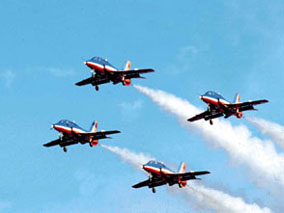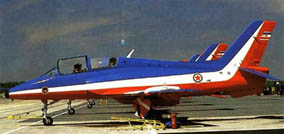Yugoslavia has a long
history of precision display flying which was first demonstrated to the public during and
airshow at Zemun – Belgrade’s military airfield – in June 1938. After WWII, a pair
of Yugoslav Air Force Jungmeisters made regular apirenses at air displays in the late
1940’s. |
These were followed by
team of three YAK-3s, a five-plane grouping of the Ikarus S-49Cs (redesigned Yak-9s) and
in the late 1950s, the Air Force’s first jet display team, flying F-84G Thunderjets. A
new team formed by the 204th Air Wing based at Batajnica (the unit’s Canadair Mk 4
Sabers being responsible for the defense of Belgrade) flew over a crowd of 200.000
spectators attending the 1960 Belgrade Airshow held at Zemun.
|
This team lasted for
five years until a four –ship group using the indigenous Soko G–2 Galeb (Gull) basic
jet trainer that performed for the first time at Ljubljana in July 1968, replaced it. The
Galeb was replaced by single –seat light attack variant of the G–2, the J–1 Jastreb
(Hawk) which was flown until 1979. In that year a pair of Czech Zlin trainers, flown by
Yugoslav Air Force instructors, took over and became the first postwar YAF demonstration
team to an overseas invent, the Venice International airshow in 1979
By 1984 the team had
reverted to flying six J–1 Jastrebs, and the following year it was officially named the
Flying stars. Over the next five years, the distinctive red, white, blue and yellow
Jastrebs of the Flying Stars became a familiar sight at airshow throughout Yugoslavia. |
They were replicated by
the G–4 Super Galeb (Super Gull) advanced jet trainer and light attack aircraft which
had made its debut in the West at the 1983 Paris airshow. |
However, almost exactly
a year after their first public appearance, at the 1990 Batajnica airshow – and just
before they were to make their international debut in Italy – the Flying Stars were
grounded by the outbreak of hostilities in Slovenia
|
During the years of
isolation and sanctions, the team’s Super Galebs were used for advanced training by the
Air Force, although some the retained their red, white and blue color schemes. Once the
decision to reform the Flying stars had been made at the end of 1996, Major General
Blagoje Grahovac, Commander of the Air Corps, gave the 172nd Air Brigade – controlling
units at Podgorica – the responsibility of choosing new pilots and working out new
routines. |
|
|
|
Pilots were selected from a large number of volunteers, all of whom were
experienced instructors and included two former members of the 1990 team, Major Istvan
Kanac and Captain Sasha Ristic. Under the leadership of Major Kanac each pilot was put
through five test flights of the Super Galeb, two solo flights with the “boss” in the
back seat, and another three outings, flying as a member of the full team.
 |
By February 1997, the team
manager and commentator (who is also the reserve pilot) and six pilots with varying
backgrounds – one is a former Mig–21 pilot, while another flew the J–22 Orao – had
been chosen and training begun in earnest. New routines were practiced using a basic
formation of four, interspersed with a synchro pair. The display is flown at between
160-435 mph (260-700 km) with the main formation maintaining a separation of only 2 ft.
(60cm)! A “flat” program for use in low cloud base condition was also designed and
practiced. The final program, which lasts for 20 minutes, was demonstrated before senior
officers in April 1997 after which approval for public appearance was given.
 The new Flying Stars, with the
three – bar roundel replacing the former red star on a RAF-type roundel, were seen in
public for the first time at the Batajnica airshow in June 15, 1997. Other domestic shows
followed at Podgorica, Nis and Vrsac, culminating in the first overseas appearance of a
Yugoslav Air Force display team for nearly two decades. On September 27/28 1997, the
Flying Stars and their support aircraft, a YAF An –26 with the groundcrews and ground
handling equipment, appeared at the Bulgarian airshow at Plovdiv Airport – Krumovo Air
Base in front of more than 50,000 enthusiastic spectators. General Velickovic, piloting
his own Super Galeb accompanied them to Krumovo.
source by Air Force Magazine
All seven aircraft of the Flying stars team were destroyed on Podgorica
airfield during the NATO air campaign in Yugoslavia. General Velickovic was killed on
Batajnica airfield at the end of the war, he was high rank Yugoslav officer who was killed
during war. |
|
|